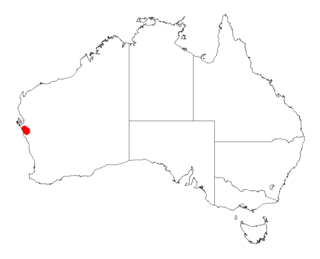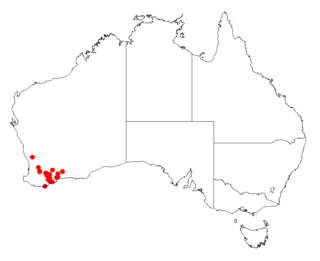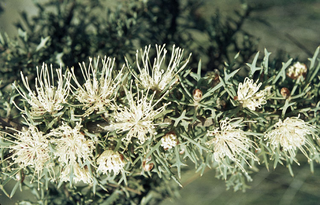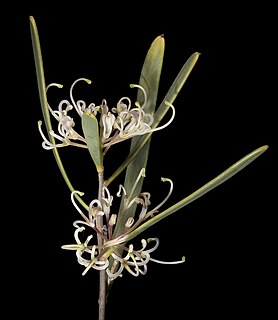
Acacia hystrix is a shrub belonging to the genus Acacia and the subgenus Phyllodineae that is endemic to south western Australia.

Acacia leptospermoides is a shrub belonging to the genus Acacia and the subgenus Phyllodineae and is endemic to a large area of south western Australia.

Acacia merrallii, commonly known as Merrall's wattle, is a shrub belonging to the genus Acacia and the subgenus Phyllodineae that is endemic to south western and southern Australia.

Acacia plautella is a shrub belonging to the genus Acacia and the subgenus Phyllodineae that is endemic to a small area along the coast of western Australia.

Acacia saxatilis is a shrub of the genus Acacia and the subgenus Phyllodineae that is endemic to south western Australia

Acacia sphacelata is a shrub of the genus Acacia and the subgenus Phyllodineae that is endemic to south western Australia.

Acacia sulcata is a shrub of the genus Acacia and the subgenus Plurinerves that is endemic to an area of south western Australia.

Acacia amputata is a shrub of the genus Acacia and the subgenus Pulchellae that is endemic to an area of south western Australia.

Acacia fagonioides is a shrub of the genus Acacia and the subgenus Pulchellae that is endemic to an area of south western Australia.

Hakea falcata, commonly known as sickle hakea, is a shrub in the family Proteacea and is endemic to southern Western Australia. It has narrow egg-shaped leaves, cream flowers and blooms in spring.

Hakea hastata is a shrub in the family Proteaceae and is endemic to southern Western Australia. It is an open, upright shrub with light green leaves, branches covered in dense hairs and white flowers in spring.

Hakea incrassata, commonly known as marble hakea, is a shrub in the family Proteacea and is endemic to Western Australia.

Hakea invaginata is a shrub in the family Proteacea and is endemic to Western Australia. It has purplish-pink flowers, smooth needle-shaped leaves and the branchlets are thickly covered in hairs.

Hakea lasianthoides is a shrub or tree in the family Proteaceae and is endemic to Western Australia. It has creamy-white flowers, mostly linear leaves and flowers from September to November.

Hakea lasiocarpha, commonly known as long styled hakea, is a shrub in the family Proteacea and is endemic to Western Australia. It has about 30 whitish flowers in clusters in the upper leaf axils, rigid prickly leaves and a limited distribution.

Hakea longiflora is a small shrub in the family Proteaceae and is endemic to Western Australia. It has sharp, short, needle-like leaves with white flowers and a prominent red style.

Hakea nitida, commonly called the frog hakea or shining hakea, is a shrub of the family Proteaceae and is endemic to an area in the southern Wheatbelt, Great Southern and Goldfields-Esperance regions of Western Australia.

Hakea rhombales, commonly known as walukara, is a shrub in the family Proteacea. It has red, pink or purple flowers and is endemic to Western Australia and the Northern Territory.

Hakea stenophylla is a shrub or tree in the family Proteacea, with sweetly scented creamy-white flowers. It is endemic to Western Australia.

Hakea sulcata, commonly known as furrowed hakea, is a flowering plant in the family Proteaceae and is endemic to Western Australia. It is a prickly shrub with grooved, cylindrical leaves, sweetly-scented flowers and relatively small fruit.






















